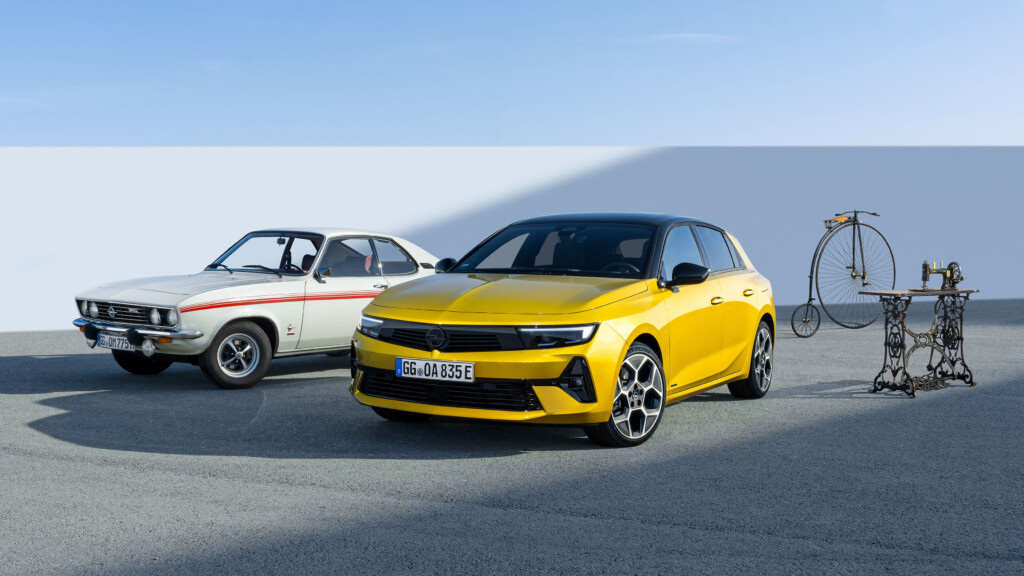OPEL is celebrating its 160th anniversary this year, and while the company is now synonymous with top quality motor engineering its first products were actually sewing machines.
Founded by Adam Opel in August 1862, Opel went on to become a global leader in bicycle manufacturing before making a name as a pioneer in automotive engineering.
Opel has a history of change, and the focus today is on becoming a sustainable mobility brand that will rely entirely on electric vehicles in Europe from 2028.
“Opel has been moving people for 160 years and today we are driven by the same spirit as the company founder Adam Opel; technology and innovations for everyone – whether sewing machines, bicycles or cars,” says Opel CEO Uwe Hochschurtz.
“All this with a clear view of the future, always ready to face new challenges.
“Many bestsellers from Opel’s rich history stand for this, as do our current models, most of which are already electrified. From 2028, Opel will be a purely electric brand in Europe.
“We are therefore well prepared for the next 160 years.”
The Opel success story began when Adam Opel assembled his first sewing machine in Rüsselsheim, Germany. Production figures quickly rose and in 1868, Adam Opel and his employees moved into a new factory.
The company soon developed into one of the largest sewing machine manufacturers in Germany and exported to the whole of Europe.
Opel built up its next successful pillar with the bicycle. In 1886 the first penny-farthing bicycle was built in Rüsselsheim, making Opel one of the first bicycle manufacturers in Germany.
Soon the range of models expanded to include tricycles and in 1888 the first Opel bicycle factory was inaugurated.
The success story continued through the decades and by the 1920s, Opel advanced to become the world’s largest bicycle manufacturer.
Driven forward by his five sons after Adam Opel’s death, Opel embraced automobile production in 1899 in Rüsselsheim, with the Opel ‘Patent-Motorwagen System Lutzmann’.
In 1906 the 1,000th vehicle was built.
Opel was the first German manufacturer to introduce large-scale production technology, with its first car to roll off the assembly line in Germany in 1924, the 4/12 PS ‘Laubfrosch’, which was always painted green.
Just three years later, the Opel 4 PS, with a base price of only 2,980 marks, meant the car was no longer an expensive luxury item for the well-heeled, but a reliable means of transport for many.
The next revolution in production followed in 1935. The new Olympia model became the first German mass-produced vehicle with a unitary all-steel body, which, thanks to its low weight, ensured improved driving performance and low fuel consumption.
The entire production process was faster, more efficient and less costly, in turn delivering more customers.
Over the course of its 160-year history, Opel has repeatedly set trends with new models, new comfort, technology and safety features, and created true bestsellers, each one born with a nod to the past, yet each one looking to the future.
The most enduring model line to date is the Kadett, unveiled in 1936. In 1962, the Kadett A became a million-seller, a driving force behind the German ‘economic miracle’ of the time.
Rebranded as Astra since 1991, the Kadett legacy continues to ensure that innovations find their way into the compact car class, with the all-new sixth generation Astra arriving in 2022, and a fully electric Astra-e due in 2023.
Indeed, Opel was on the road to electric as early as 1971 when the Elektro GT set six sensational electric car world records on the Hockenheim racetrack.
Opel continued its role as electric pioneer in series production vehicles with the electrified Opel Ampera, Europe’s ‘Car of the Year 2012’, establishing a new segment in the European automotive market.
With its range extender, the coupé-like four-seater was the first electrically driven vehicle suitable for everyday use with a range of around 500km.
The Opel Ampera-e, a purely battery-electric compact car, followed in 2016. A single charge of the 60-kWh lithium-ion battery provides a driving range of up to 520km.
The Opel Manta sports coupe became a cult car in the 1970s and 1980s. The Manta A inspired with its design and striking front visor, which today is reincarnated as the Opel Vizor and adorns all new Opel models, from the current Mokka, to the new Grandland and new Astra.
The public emotions aroused from the unveiling of an electrified Opel Manta GSe Elektromod model in 2021 secured the production of a new Manta-e in the near-future.
Born in the eighties, the Opel Corsa small car celebrates its 40th anniversary this year. Right from the start, it quickly became the best-selling vehicle in its segment.
In 2019, Opel launched the Corsa-e, the brand’s first all-electric compact car, making e-mobility accessible to many customers across Europe.
The range of electrified Opel models, plug-in hybrids and battery-electric, today spans Corsa, Mokka, Grandland, Combo Life, Zafira Life and the full Opel van range, with the Vivaro-e mid-sized panel van crowned Irish Van of the Year 2022 and enjoying top position in electric van sales in Ireland year to date.
By 2024 all Opel models will be available in electrified variants and by 2028, Opel will be purely powered by battery-electric vehicles in Europe.
